For the second instalment in this series, I’m very fortunate that Ryan Laukat, arguably one of the most fascinating designers in board gaming today, was kind enough to sit down with me and talk about Sleeping Gods.
The full interview was almost 2 hours long, so I had to edit it down to a readable length and split it into two parts. This is part 1 where we talk about the origins of Sleeping Gods, creating a new world, and the writing process. Enjoy!
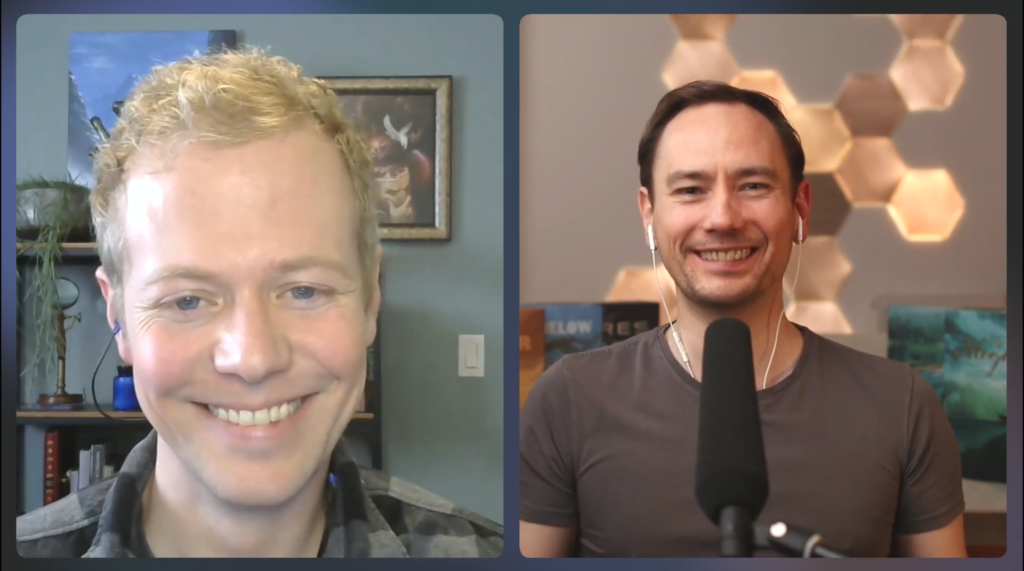
The Beginning
When I did my preparation, I noticed that I have a serious problem both in talking to you and in talking about Sleeping Gods specifically, because there is so much to talk about. I play a lot of your games so I’m used to “how can one person create so much art? Do so much game design? Metal coins? Miniatures? …”.
So I thought let’s narrow it down a bit and get rid of all that I could ask you for any of your games but be specific with Sleeping Gods. And the thing that stood out to me is a big resounding HOW. How is this game even possible? Because when I think about it: it’s an open-world game, a board game, it has A LOT of content, it is an original IP, it’s cooperative, there are so many things in this one board game I’m actually wondering how was this possible? I was hoping we could go down a bit the journey you actually took.
Ryan: Yeah, that makes sense. This is a conversation Malorie and I have quite often. The truth of it is: with these big projects like Sleeping Gods, the main challenge is I get burned out like near the end. [both laugh] Or maybe halfway through the development because there is so much stuff to do. So I guess fighting the burn out is maybe part of the issue.
I remember when I got into board games, when I was designing as a kid, and in my twenties when I was trying to get games published. One thing I thought was that because I am a video gamer, I wanted more than just one board’s worth. I wanted multiple boards, I wanted to explore a lot more. When I played Tales of the Arabian Nights, one thing that excited me was [that] there was this book, this thick book, and it was just full of possibilities. And I thought oh my gosh, other games you can see the entire thing. I loved the mystery that there was so much in there that I would probably never see. And just that idea was such a strong motivation to create the whole thing. So I guess that is the thing that kept me going.
But where did you start? Can you remember what your first memory of starting working on Sleeping Gods was?
Ryan: Well, I want to go back to Above & Below, because that was our first story book game. I designed the game without a story book, it was just mechanics. I played it with Malorie and she’s like “this is pretty good, it was kind of light, this is fun”, and as we were playing I thought “what if we added a story book?” and she said: “No!”. [Alex & Ryan laugh hard]
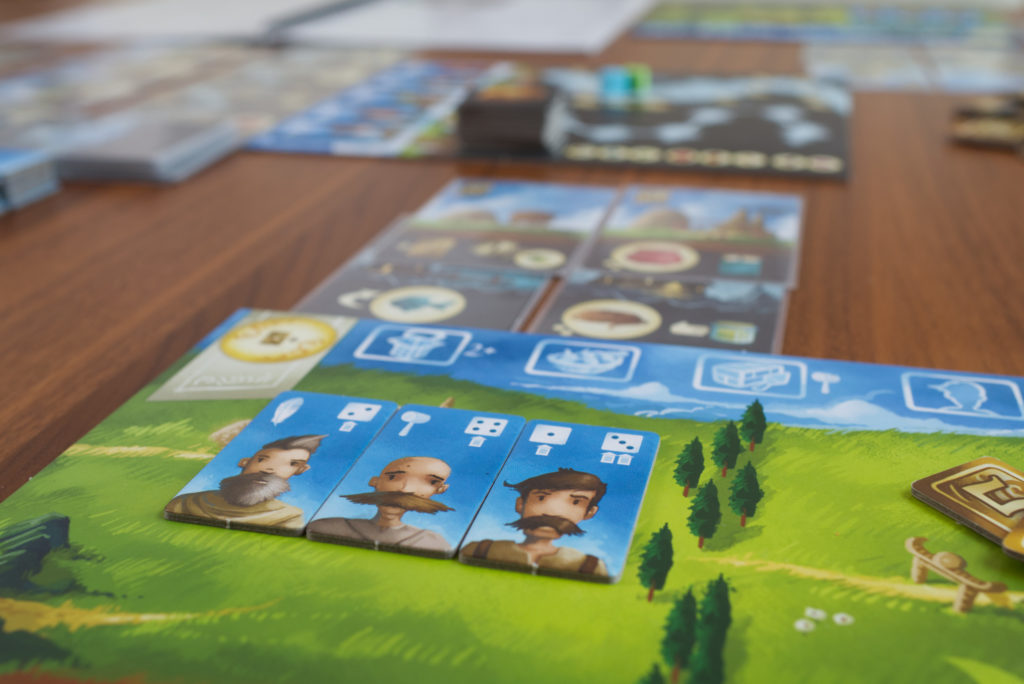
“No, that’s not a good idea” and I was like “there is nothing like that, it’s like a euro-game, like a light euro-game with a story book!”. So we ended up doing that pretty quickly. And then I remember for Near & Far I was thinking I want to expand this. I want to create a bigger world to explore and that was where the atlas came from. You explore the atlas. At that time, there hadn’t been really many games that used a book with a spiral binding. I think the only one I had seen was like a Titanic game. I remember seeing that and thinking oh my gosh, we could do tons of maps in a book like that.
To be honest, I was still thinking very much in euro-game design sensibilities for Near & Far. So after we published that and Empires of the Void 2, I was playing Zelda Breath of the Wild and I thought nobody has really done this very much you know. I would love to create an open-world board game. And that was sort of the moment when I started working on designs.
I had played open-world video games a lot since I was a kid but I was still stuck in euro-game mentality. So the first prototypes for Sleeping Gods, I was stuck on that “euro-game victory point thing” and it took a long time to break out of that if that makes sense.
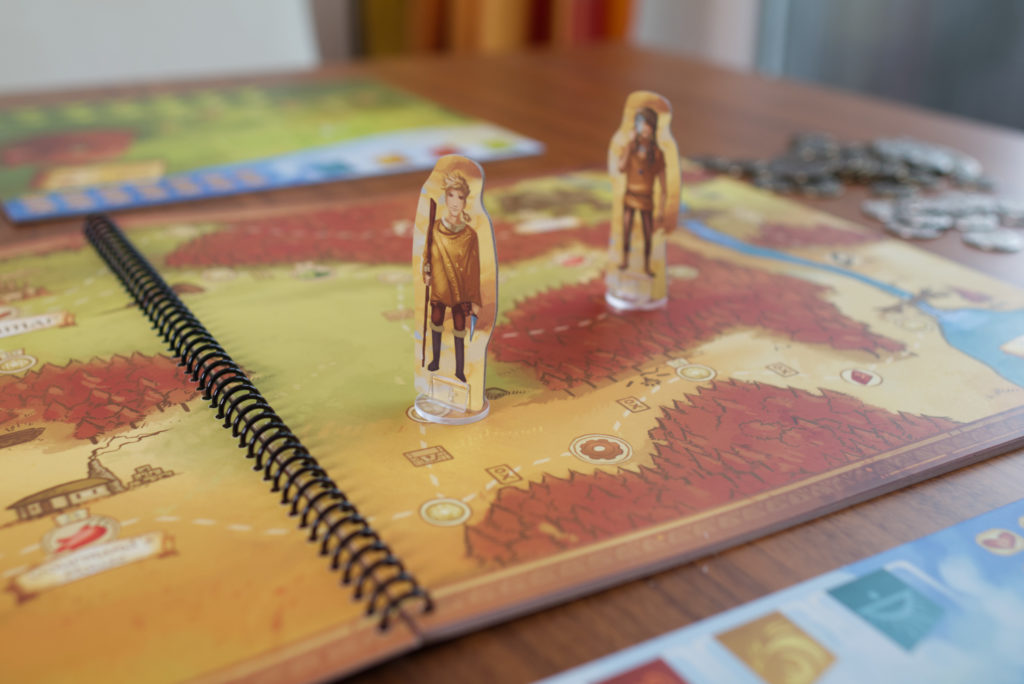
When you started out, what was the landscape in board games like? Nowadays we have Lands of Glazyr, 7th continent, Stars of Akarios. There are so many things that have the sort of label of “open-world” but I guess when you started out, there was nothing really comparable?
I did see 7th continent. I want to say that’s really like the first persistent open-world game. I hadn’t played it but I thought it was really interesting that somebody was attempting kind of THAT. I actually didn’t play it until – I think – after we had finished Sleeping Gods. But it was really interesting to me. I saw that and I thought “wow, somebody else is giving this a shot”. But it’s true. Back then there weren’t many.
As a teen I played a lot of tabletop role playing games and those to me felt like that was really the table top open-world game. You could go anywhere, you’d complete quests. In fact, that’s what a lot of open-world games are based on. But in the board game scene there weren’t many. You could kind of say that Tales of the Arabian Nights was sort of an open-world game because you could travel in any direction. It kind of had trappings of an open-world game but mechanically it hadn’t focused on that.
And that was what I was thinking: what can we do mechanically that would make it feel more like these open-world video games? Because I really wanted to give players this huge sense of agency. You could go anywhere right when you start playing the game. That was important.
You often talk about memorable moments. Were there specific things you were thinking about back then? Can you describe what feeling or experience you were aiming for?
Ryan: I really wanted the characters to play a bigger role in the game than in a lot of previous board games. I was thinking specifically of Baldur’s Gate actually. I played that as a teen and one thing I loved about the game is that the characters would interact with each other. They would say things, and I thought “okay I want THIS”. I want specific named characters.
That was actually one of the huge challenges of the game. I know sometimes people will say “oh the characters aren’t that present in Sleeping Gods” and they could be more present, but that was the main challenge. I was like: “okay we are gonna write this narrative, but we’ll have all of the characters around all of the time”. Anywhere you go it has to make sense. If I go over to this weird place, we have to have the characters there because anybody could say something at any moment.
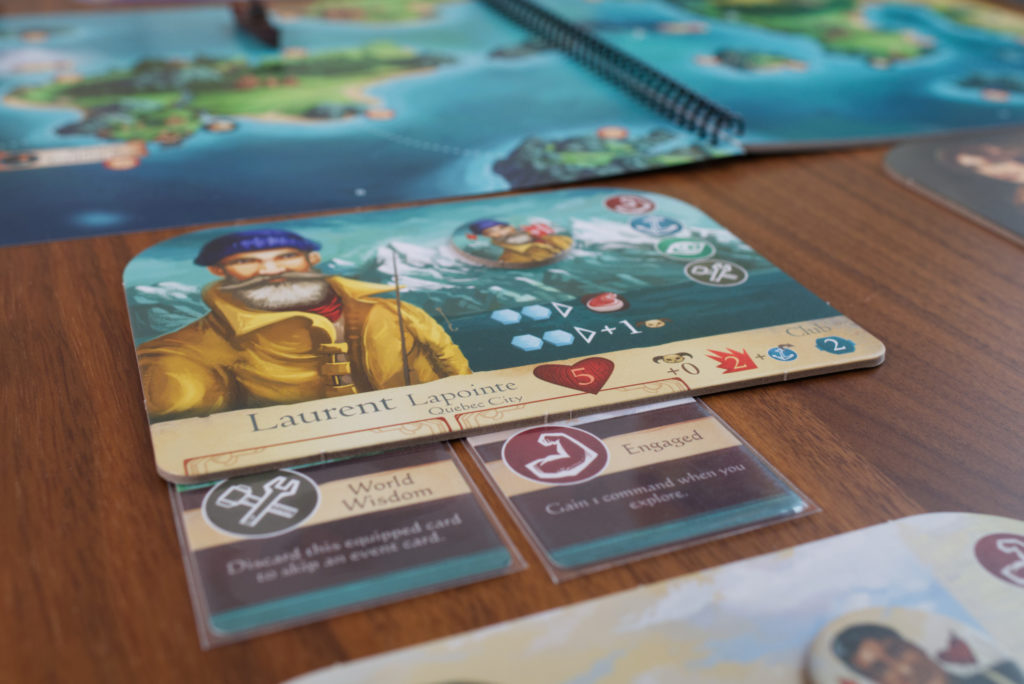
I think that was one of the biggest challenges, but I thought having those characters, it will make you care about [them]. Mechanically but also in a narrative sense. I was hoping that would create some of the memorable moments, that and the quest design of course. Starting a narrative and then getting to an end. That was something that I saw would motivate players in play-tests.
I didn’t realise it would be such a motivation until I sat down with people and I would give them victory point motivations. I would give them a carrot on a stick, follow this victory point motivation, nobody cared about that. The thing they cared about was: they would start a story, they would make a choice, and really wanted to see how it ended.
There was one guy who was sitting at a play-tester table and he had to go, it was time for him to leave. But he kept sticking around, he was like “guys we have to hurry, I really want to see how the story ends”. And I thought oh my gosh, that’s enough!
In the Crafting Arzium documentary, there is this interesting moment where you are pitching the next game idea to Malorie. And I was wondering how did you pitch to her doing Sleeping Gods?
Ryan: I think it went something like this. I was like: “okay, so I want to do a big game like Near & Far, but make like a huge open-world”. At the time [we had] learned so much from Above & Below and Near & Far, and even Empires of the Void 2, because we tried to incorporate different narrative like the narrative that comes from the event cards you play. I was trying to create stories without having players stop to read a book and I felt like we could take a bunch of that stuff just kind of put it all together and simulate some of these old video games I had grown up on.
It’s weird because, there are moments where we are finishing a game and that feels completely different. And then there are moments where it’s like creative time where I just throw a bunch of ideas out and we will make a bunch of prototypes for different games and a lot will just end up on the shelf or in the trash and this time … it was just one of these things. I pitch stuff to her all the time actually. [both laugh] Most of it doesn’t end up getting published.
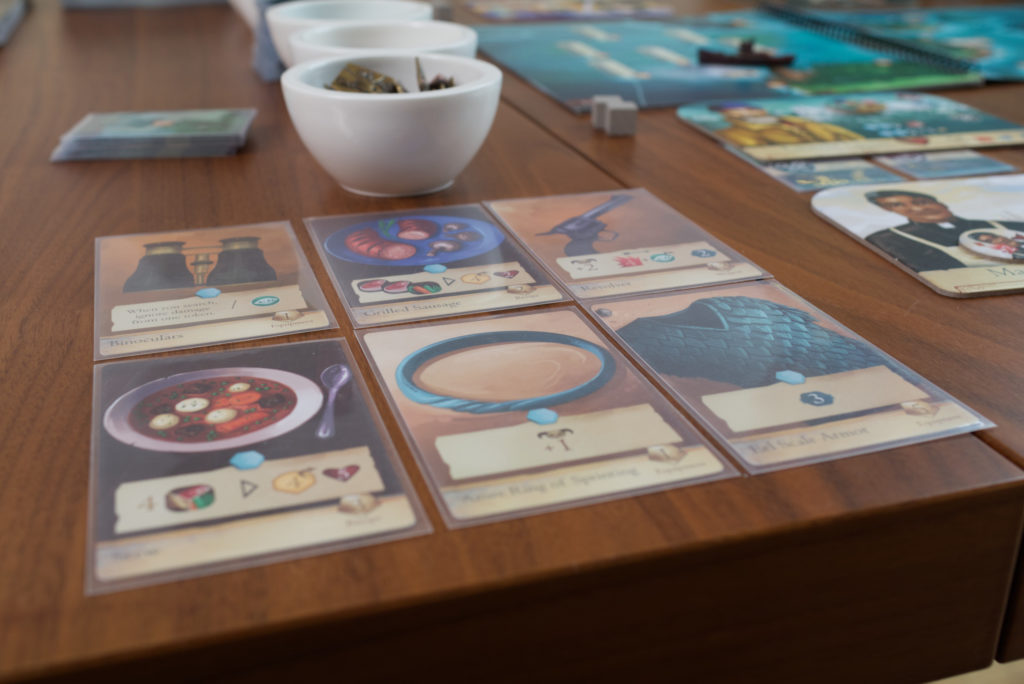
Because she blocks it or why?
Ryan: No, it’s usually because I’ll work on it for a while and it won’t be going anywhere … and it’s always more exciting to start something new than to work on something [for] too long. So usually stuff that is not too fun, I just put to the side. So I think at the time she was like “okay, try it, we can try it”, knowing that it might not go anywhere.
Did you already imagine how big the scope would be? Because I would have thought the way I saw in the documentary, she is both your biggest cheerleader but also like the producer that says “no, we cannot do that, we can’t afford it”, the sensible person an artists needs. So I was thinking you might be pitching Sleeping Gods and she would be “are you out of your mind, how big is this game?”
Ryan: [laughs] yeah. When I come up with a game, it’s usually twice as big as what it ends up. I can remember drawing a world map for Sleeping Gods. Right now, there are 9 maps, in total 13 with the expansion. When I had originally drawn that grid it was like 26 or something. I started working on it and talking to Malorie and she’s like “okay, we are gonna be writing for the next 10 years, we are gonna pare that down a little bit”.

I’m very bad at deciding how long something is gonna take. I’m not good at time management. I always think something is gonna be way easier and faster than it ends up being. I just saw a quote the other day where Rob Daviau said to Matt Leacock: “hey, I think we are 80% done with Pandemic Legacy” and Matt said back to him “oh good, we only have 80% left”. And that’s how it is.
You often mention that one of the first things you do is paint the cover to set the mood. I guess with sleeping gods you painted the cover and then dove right into painting the map?
Ryan: Yes, I started painting the map and I actually went through a few different styles with that map. The first map I painted was just the original map that you start on. And I didn’t like the look of it, so I repainted it maybe 3-4 times. I remember one of the times, I spent so much time painting so many tiny little details. And I looked at the final thing and said “no, no, this is not right”. It was taking forever but it wasn’t even looking that good. I tend to do that as well. It takes a lot of time to zero in on the art style. Like the crew members, that was the other thing I had to paint really early because I knew the crew would be really important and we would be writing stories about them. We had to know what they looked like.
And so the first pass of the crew, it was pretty rough honestly. I spent a few months going back to each crew member, kind of changing how they looked a little bit, changing the art style a little bit. To be honest, I simplified their look a little bit as I went along. For Sleeping Gods, I was trying to make the characters look a little more realistic than some of my previous games which were a little bit more “cartoony”. Obviously Sleeping Gods does’t have a super realistic style, everything I do has a somewhat “cartoony” look to it, but I hadn’t done characters like this very much before. So it took a long time to get the crew right.
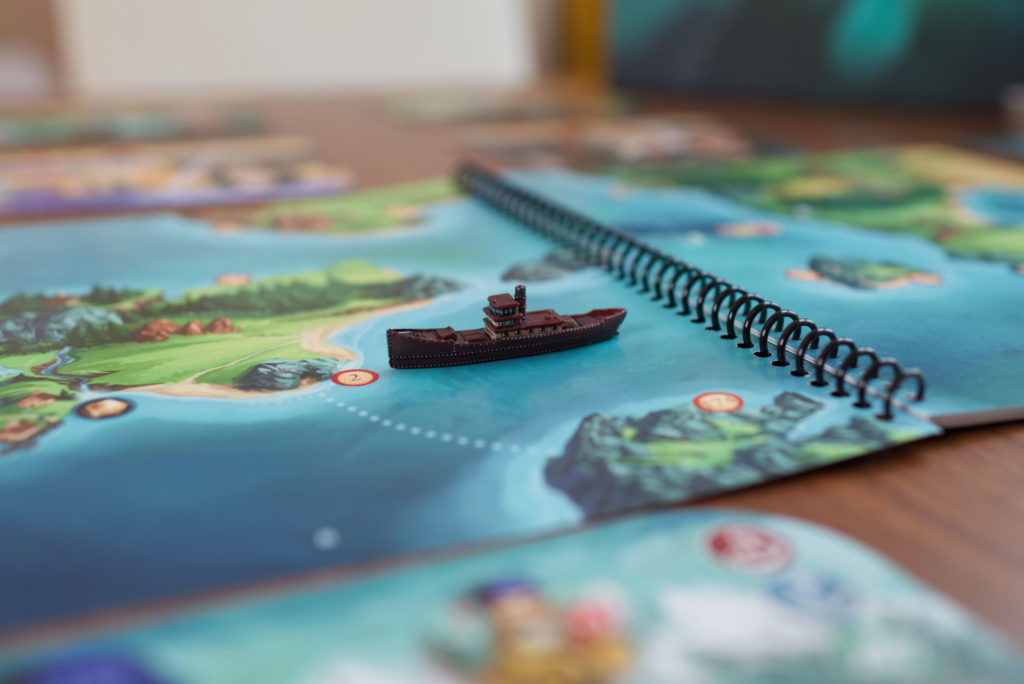
What was the motivation about making things more realistic?
Ryan: I wanted this to be a slightly scarier and darker story than maybe a Near & Far and Above & Below. For one thing, it is set in a different world and I was hoping people… You know sometimes people, they will call it the Laukat-vers and everything is kind of the same thing. But there is Arzium and that’s the Near & Far and Above & Below world, it has like frog people and lots of animals. And then Sleeping Gods was supposed to be more of, to be honest, more of a horror style game. I know when they play it, they still feel like it is whimsical and fantastical, and it is, but it was more based on the Odyssey. I was reading the Odyssey when I was creating it. Actually the first name for the game, it wasn’t Sleeping Gods, it was Odyssey 1929.
That was the original title of the game. I have the box. When I painted that box, the name there was Odyssey 1929. And I had a copy of the book and I remember we were traveling and I was reading it. So you can see a lot of the trappings of that in the game. It’s captain Odessa, you know, she is based on Odysseus, and of course you run into things you would find in the Odyssey, just a slight twist on that.
One thing I noticed – especially with the art style it is right now – is that it is really obvious we are no longer in Arzium. But there were also a lot of moments where people actually leaned over the atlas, looked very closely, and were thinking “is that like a bird or rock or?… let’s go there!” The uncertainty really helped to enrich the world beyond what you drew and put into the story. There was room for people to put their own imagination in.
Ryan: Absolutely. That’s so good to hear because I think that’s the strength of a board game. To be honest, I think board games aren’t necessary a great story telling medium compared to the novel for example. There is so much you have to get right in a board game and there is such a barrier to entry. I can just open a book and start reading and I’m there. I’m in a new world. With a board game, you have to get through the rules and depending on the group you have, that totally changes your experience. But my hope was that the game would inspire people to make it their own. That’s really the strength of a board game narrative. It’s that the players get to contribute to the world.
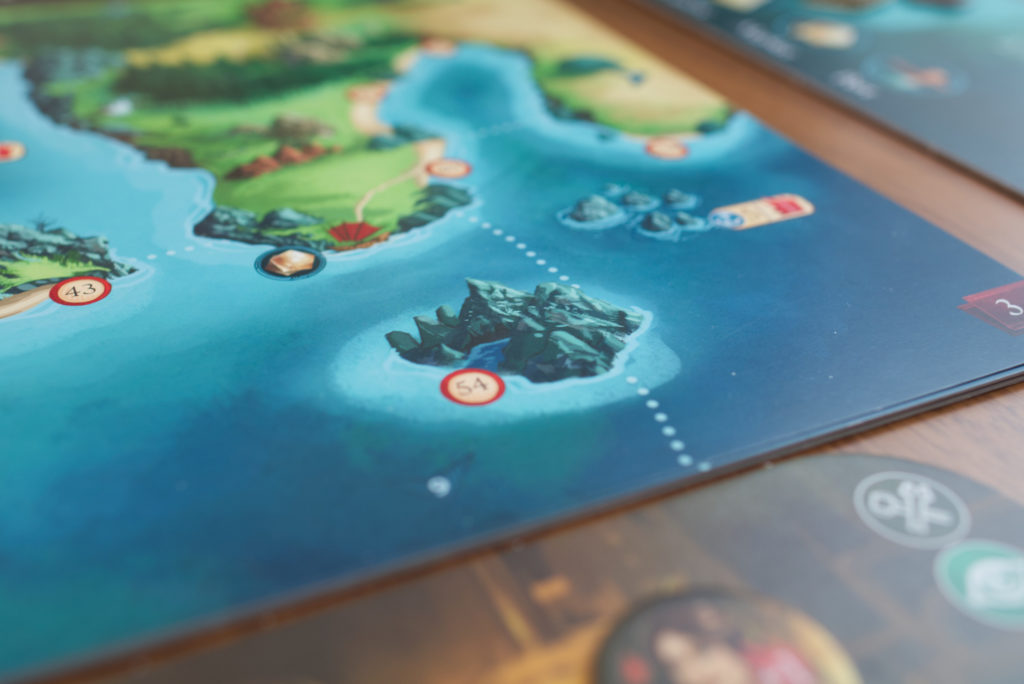
The Writing Process
And as you mentioned in the beginning, the amount of content and this freedom to go anywhere you want definitely helps. I’ve played I think 6 campaigns up to now. And I think I might be through a third or half of the content as far as I can tell, so I’m like blown away always.
Ryan: Wow, that’s amazing.
One of my favourite comments when I looked through BGG forums was someone calling Sleeping Gods “this is a completionist’s nightmare”. Did you think it would need so much content to have exactly that experience?
Ryan: I think there was a feeling like … that yes [both laugh], it needed a certain amount of content to feel like a big open world. I remember playing Breath of the Wild or Skyrim and there was a moment in both of those games where I was walking and “what, there is more? I thought this was the edge of the map? Oh the map is actually 5 times bigger than I thought!”. You can’t completely create that feeling in a board game but I wanted to sort of have people feel like that way. And I wanted people to say “oh, we have to play another campaign”, or “we could if we wanted to. We haven’t seen everything, we haven’t nearly seen everything”.
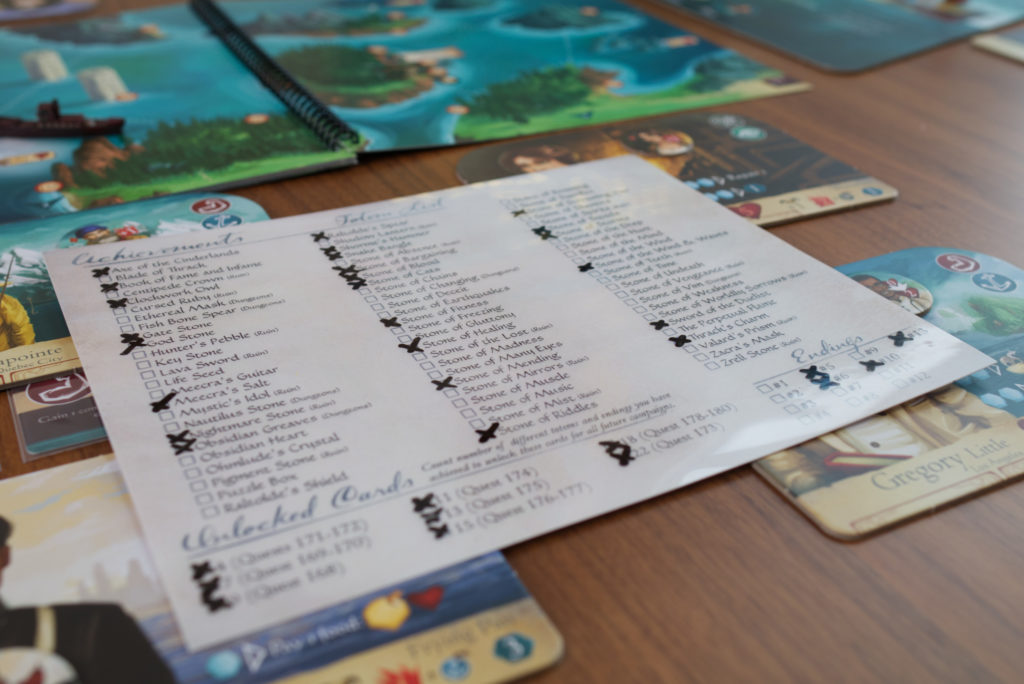
When you designed it, were you thinking people would play 1 campaign, 3 campaigns, 10 campaigns? What was the assumption you were working under?
Ryan: My first thought when we were making it was “okay, it has to be big”, but I was thinking I doubt anyone is gonna even finish one campaign.
[Alex laughs] Really?
Ryan: Yeah! I thought, I don’t know, people will be excited about this, but I think very few people will actually finish one campaign. That was my biggest worry actually. They’ll play 3 hours, get bored and then move on to the next game they have on their shelf. And that was my biggest surprise actually: how many people finished a campaign and how many people played multiple campaigns, like yourself. Honestly, I’m so shocked that people are playing multiple campaigns.
With so much content, how did you manage to keep everything consistent. You weren’t the only person that was writing, Malorie wrote stuff, Brenna Asplund wrote stuff. You said you painted the characters, but did you also create character treatise in the beginning or did you write Mac’s Journal and said, hey, here is a book that describes how the world works?
We hadn’t written Mac’s Journal yet, but we had a Google Sheet. We had all the pictures on there and short backstories for each character. It was a world bible, [that’s what] we called it. And we had different lore and creatures. I had a list of all the gods and just like a short description of the god and what they looked like, what they were the god of, and different places. I would write the description of all the places. I mean things changed as we went along. That’s really the tough thing because it’s kind of like you get to a point where it’s like dragging an elephant. And everything, every change you make is huge.
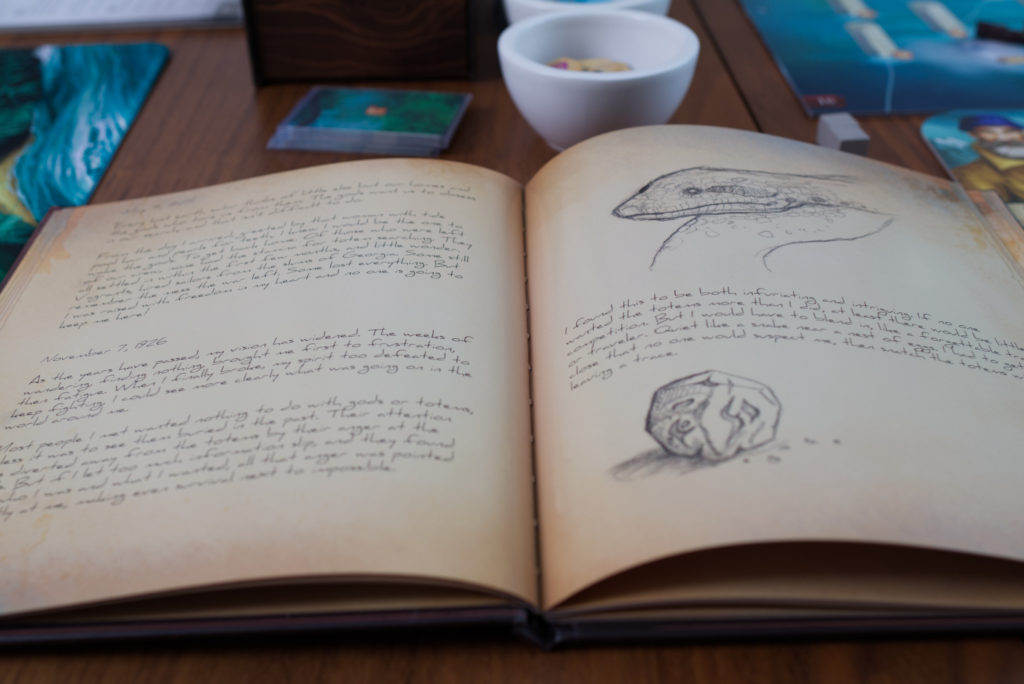
I can remember things like we would write a lot of story book. We had like 60000 words of story and then I realised we have to change this detail about this one character. So we had to go through the entire thing and every time that character says something or mentions something, we have to fix that. Oh, is this in line?
At the beginning, when we first wrote the story book, the gods were trying to awaken, but for some reason – I hadn’t thought this through – the gods were also putting obstacles in your way. Like trapping you and tricking you. There weren’t a ton of stories like that but they were in the book. I remember a moment where we had to have a company meeting and I said “hey guys, the gods are not trying to trick you, they are trying to awaken” [Ryan & Alex laugh hard]. “We have to go through and fix everything that is like that”. And so it’s a few weeks going through each story and altering characters, changing dungeons and stuff like that. Every time we made a change like that it was so much work.
I guess you weren’t particular popular in that week, right?
Ryan: [laughs] Right! We would make changes like that, maybe the team wasn’t so happy. I would have that document we shared and we would have company meetings occasionally where we would talk through story ideas or certain endings. I remember Brenna would pitch to me, because she wrote a couple of alternate endings. She would pitch them to me to see if that would fit in and work with the setting. So for Sleeping Gods: Distant Skies, I actually wrote a much more detailed world bible. I wish I had been more detailed honestly with that first game. Having as much detail as you can right off the bat really helps.
Did you use any specific tools? I guess for interactive fiction there are dedicated tools to do stuff like this. What kind of writing process did you have in Sleeping Gods and how did it change for Distant Skies?
Ryan: We did look into some of the branching narrative tools, the software that was out there, because we thought it would really help with the development. But we couldn’t find anything that would be easy to export it into a book document. There might be something like that now, but at the time there wasn’t anything that would do it easily. So we just ended up writing the old fashion way, writing on a word document.

Wow!
Ryan: Yeah. What we did originally was: we had to change all the numbers, we would write each story location separately and then when it was all done, Malorie went through everything and re-numbered everything so it would all fit together.
Anyway, we learned certain things like okay, it will save us time if we just start numbering it exactly the way we want to right from the beginning. So, hard lessons learned along the way.
Something that’s very unique about Sleeping Gods is the narrative structure you use. We have one beginning, multiple endings, which I just learned a couple of weeks ago can be drastically different. I found one ending where I was almost at the end of the second event deck, and suddenly something happened which was amazing and everything was great. The crew was at home, the world was still okay, and I was like “but I haven’t even played through the third event deck, this is possible?” I was wondering how you, during the development phase, thought about this. There are so many advantages of having that loose connection of independent quests between the start and end, but of course it’s also a problem because the overarching narrative is maybe lost a bit.
Ryan: It is really tough to do an overarching narrative in a setting like that. If we would be making a video game, let’s say something happens to one of the characters and they die or they left the crew, or we get a new character that wasn’t there from the beginning, we would just program that in. So anywhere we go in the world, the software knows that a certain character is there and it makes sense. For Sleeping Gods, in a board game, it’s really hard to keep track of that stuff. Every story has to make sense no matter where you have been. I think that was a big challenge.
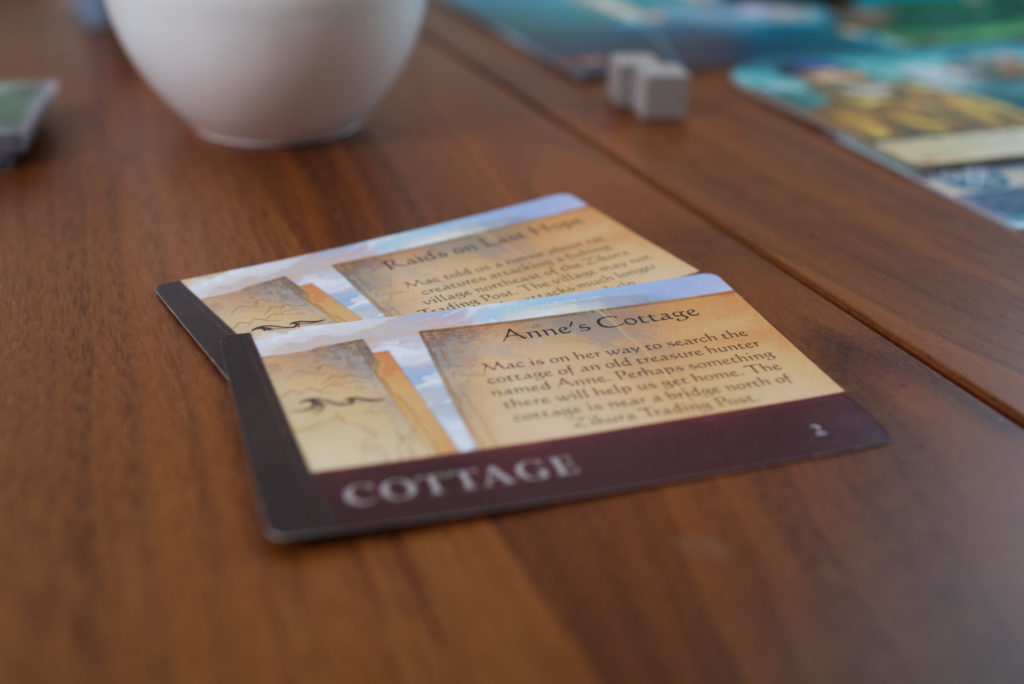
Maybe this is a downside. Nothing can be extremely permanent. Nothing can be too permanent. We can’t lose characters. If they say something here, what they said in the bottom left corner of the map has to make sense with what they say way over here too. So that’s one thing I think makes it hard to do an overarching narrative. I think Sleeping Gods: Distant Skies has a stronger overarching narrative. But, this has been something I have been thinking about quite a bit. There has been tension thinking about what an open-world means to an overarching narrative. Because in some ways, if you force players too much down a certain path, then what’s the point of the open world?
It’s weird because for example in Skyrim, there’s a main story line. If you only do the main story line, the game is only 10 hours or something. But there is so much more to do, that’s the whole point of the open world. You can go so many different places, so many different stories. So I think, in some ways, the two kind of are at odds with each other, but especially in a board game setting.
Did you anticipate that some people might feel lost because they don’t know what they are supposed to do?
Ryan: We did worry about that. For a while, we didn’t have quest cards. We only had keywords. So you would go somewhere and it would tell you to write down a keywords. Soon players would get this giant list of keywords but they couldn’t remember what they meant or all the stories they had. And I thought oh my gosh, we have to create these cards that explain the stories, because people are gonna forget what they have done. It sort of is a huge motivator actually to read through your quests and say “oh, we have to do this, we gotta try this thing”.
The reason I was reluctant to do it though was because I knew that it would double the number of cards in the game. And it did, but it was really worth it to have those. Learning how important those quest cards are was huge. It just kept going through the sequel. In some ways it feels like the game is build on those.
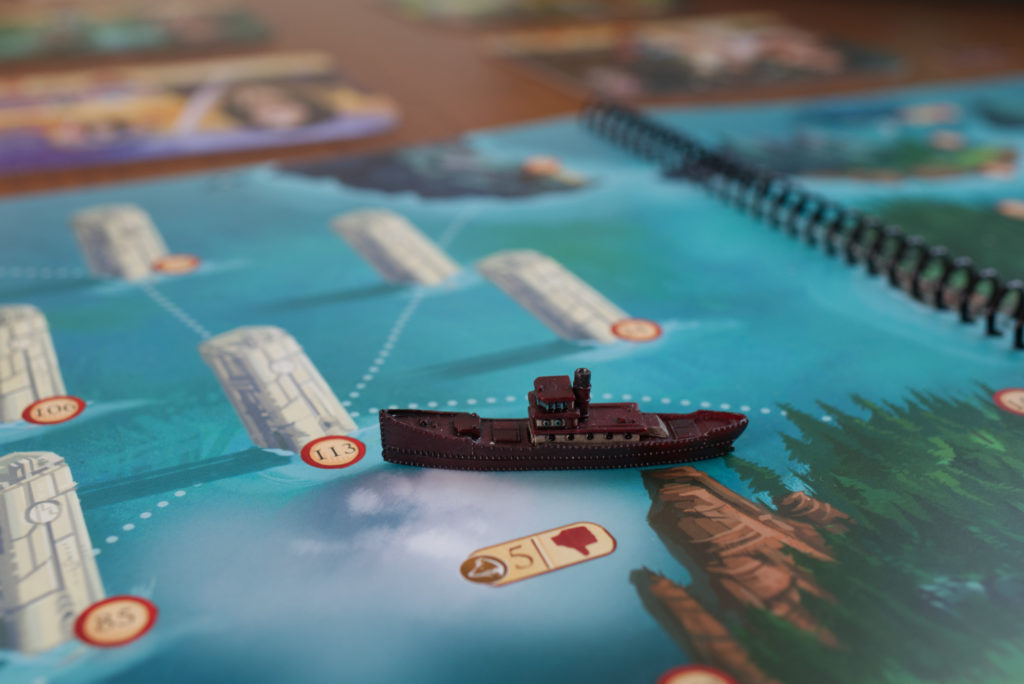
In User Experience design, there is this concept of having a “garden path”. If you take a complex software like Adobe Lightroom for example, there are so many functions a user can use that the designers actually thought what’s the main path people will go and lets make this nice and as effortless as possible. But they also allow them to branch off and go somewhere else and maybe they will end up in thorns, but they can go there.
Did you actually put a garden path into sleeping gods? Because in my first campaign, I had the feeling you wanted me to go somewhere but I wasn’t sure if I was just interpreting that or if you actually put something in there to design where the first campaign might go through.
Ryan: Yes, especially in the beginning of the game, there is sort of a garden path to follow. I think maybe something that turns people off when they play the game is that garden path has like hidden bear traps. [Alex laughs hard, nodding]
I wanted the world to feel really dangerous and unfair actually. That was a huge breakthrough as well. There was a point in the design where I was thinking about the game like it was a euro-game. So everything was fair. If you went somewhere, if you put this much effort in there you would get that much out of it. And there were like little victory points. They weren’t called that, but they were in the game.
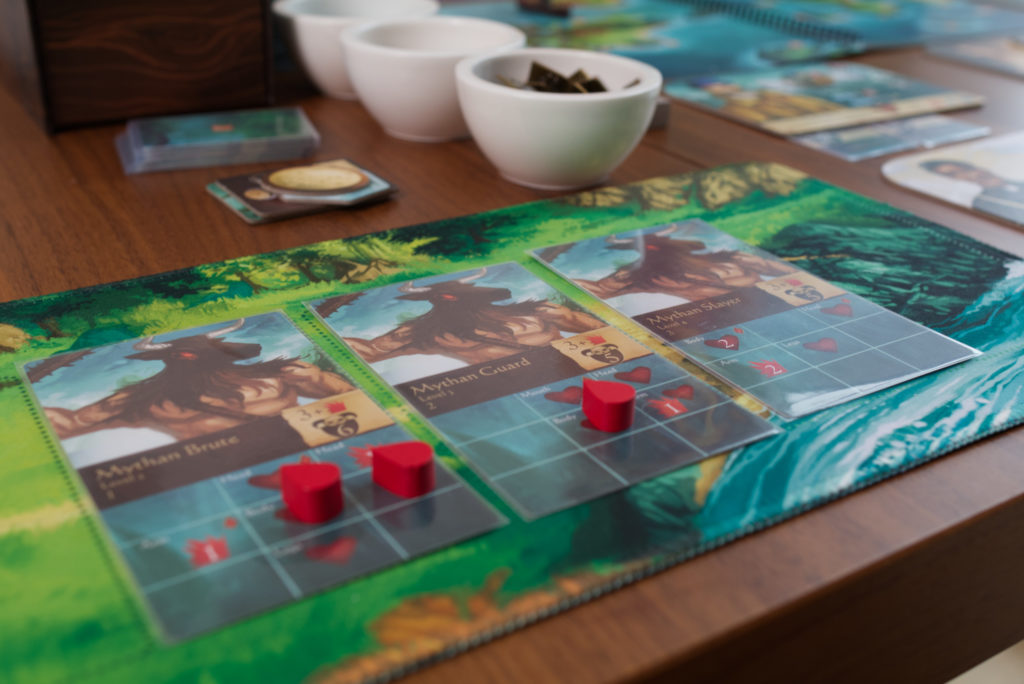
It started to get predictable and kind of boring and I think a breakthrough for me personally [was realizing], “okay, you know what, this is not a euro-game” and it is not supposed to be fair actually, for narrative reasons. The narrative actually makes more sense if it is unfair. So you go somewhere and it hurts you, it doesn’t give much back but it just hurts you. You could say maybe I went too far in some places but it’s like creating that sense of peril. For me, that really gets me engaged in the game. Sometimes you might go somewhere and get something awesome just for nothing, it’s free, an amazing bonus. Having some unpredictability there really creates more. For me, it’s more exciting and rewarding narratively.
This concludes part 1 of the interview. In part 2, we talk about getting the difficulty right, player motivation, the game almost getting scrapped, public reception, where the genre might be going and – believe it or not – Sleeping Gods in Space! So stay tuned for part 2…
If you enjoyed reading this, please leave a thumbs up or feedback in the comments. Doing in-depth interviews like these takes a lot of prep & research and it’s really rewarding to see that so many of you seem to enjoy reading them. Showing your support helps getting future interview partners on board! You can find more interviews like these in the interview section.
(Disclaimer: This is an edited version of a 2-hour conversation. I’ve tried to keep it as close to the original as possible and did minor corrections/omissions where they were needed for better readability. I had to cut out some tangents we went on though, otherwise this would have been even longer. Many thanks again to Ryan Laukat for taking so much time out of his very busy schedule and allowing all of us an in-depth look into Sleeping Gods.)

A great read! Very interesting to hear more about RL’s design choices